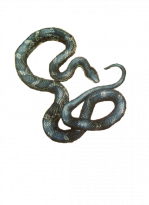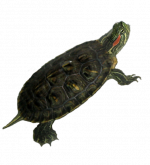Herpetology is the study of amphibians and reptiles. The two groups are included under a single discipline because historically, they were considered “lower forms” and not worthy of detailed investigation.
Although they share general similarities in appearance, there are important differences between the class Amphibia and the class Reptilia. In fact, reptiles are more closely related to birds and mammals than they are to amphibians!
Reptiles
- have scaly waterproof skin.
- have eggs protected by a thick shell.
- are less dependent on water.
- do not undergo metamorphosis.
Amphibians
- have permeable skin.
- have permeable egg membranes.
- are constrained to moist habitats.
- most undergo metamorphosis.
Currently scientists recognize over 6,500 extant species of reptiles in 50 families in 4 orders. The four extant orders of reptiles are:
Rhynchocephalia
- 1 living species
- only found in New Zealand
- similar in appearance to lizards but skull is rigid
Learn more about our Amphibian and Reptile Conservation program
Visit our Herpetology Collection website

